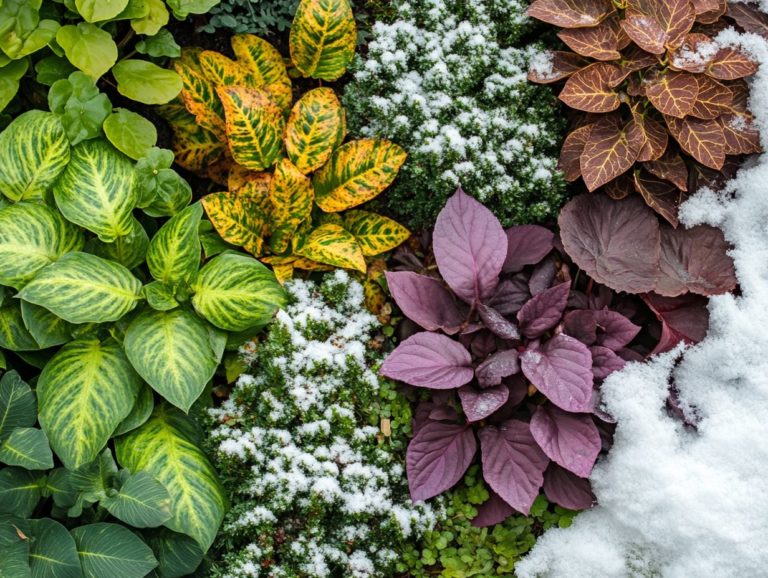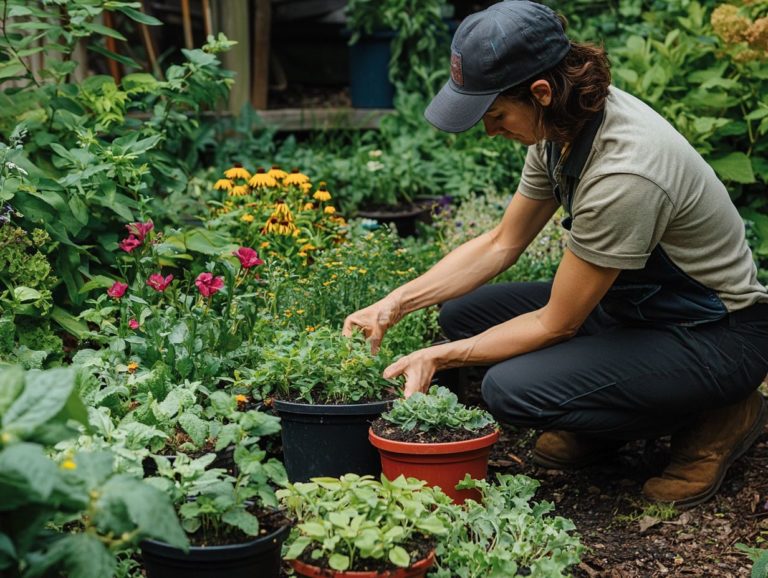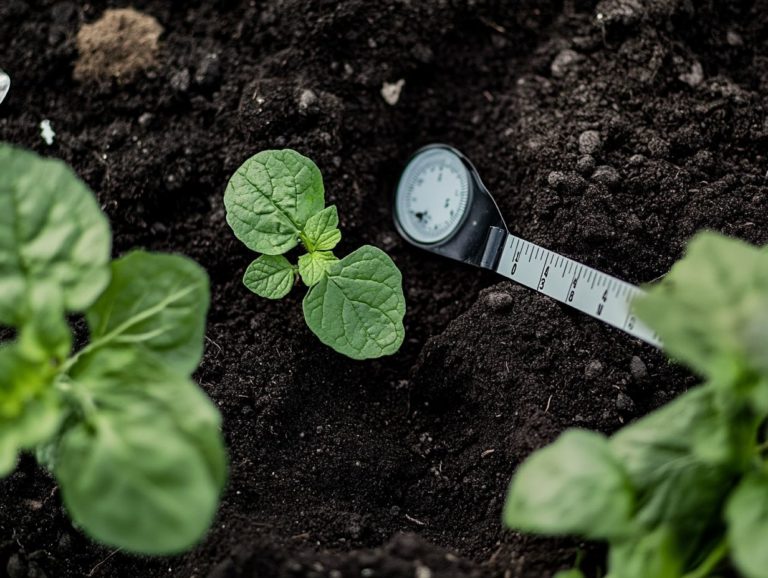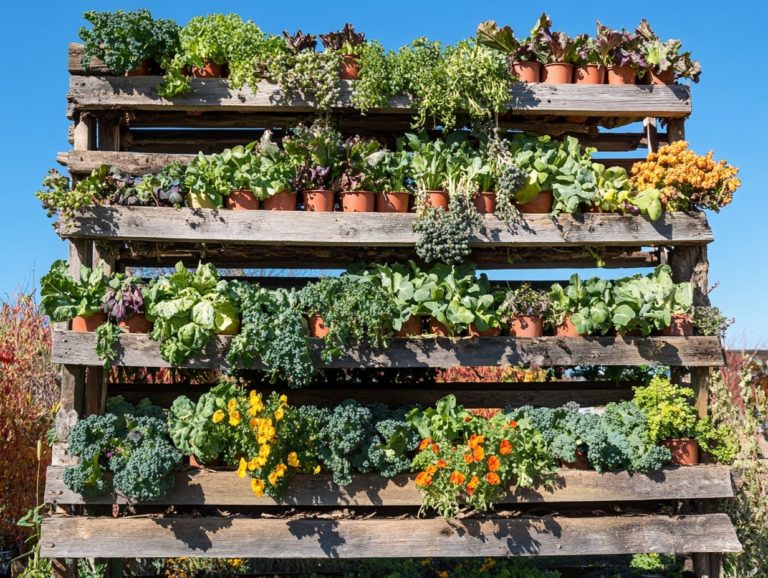Top 10 Ground Covers for Cold-Climate Gardens
Creating a stunning garden in cold climates is an exciting challenge worth taking on! Choosing the right cold-hardy ground covers can truly transform your space.
Here are the top 10 ground covers that flourish in chilly conditions, from the fragrant Creeping Thyme to the vibrant Golden Creeping Jenny, both excellent examples of low-growing perennials.
Ground covers play a crucial role in maintaining soil health, controlling erosion, and managing invasive species in your garden. You’ll also discover design tips and common pitfalls to avoid along the way.
Prepare to turn your garden into a thriving oasis with beautiful blooms and vibrant colors!
Contents
- Key Takeaways:
- 1. Creeping Thyme
- 2. Snow-in-Summer
- 3. Irish Moss
- 4. Sweet Woodruff
- 5. Alpine Strawberry
- 6. Blue Star Creeper
- 7. Mazus Reptans
- 8. Bugleweed
- 9. Corsican Mint
- 10. Golden Creeping Jenny
- What Are Ground Covers and Why Are They Important for Cold-Climate Gardens?
- What Are the Key Factors to Consider When Choosing Ground Covers for Cold-Climate Gardens?
- How Can Ground Covers Help with Soil Erosion and Weed Control?
- What Are Some Additional Benefits of Using Ground Covers in Cold-Climate Gardens?
- What Are Some Common Mistakes to Avoid When Using Ground Covers in Cold-Climate Gardens?
- How Can a Gardener Incorporate Ground Covers into Their Overall Garden Design?
- Frequently Asked Questions
- What are the top 10 ground covers for cold-climate gardens?
- What is the benefit of using ground covers in a cold-climate garden?
- Are all ground covers suitable for cold-climate gardens?
- How do I choose the right ground cover for my cold-climate garden?
- Do ground covers require a lot of maintenance?
- Can I use ground covers as a lawn replacement in my cold-climate garden?
Key Takeaways:
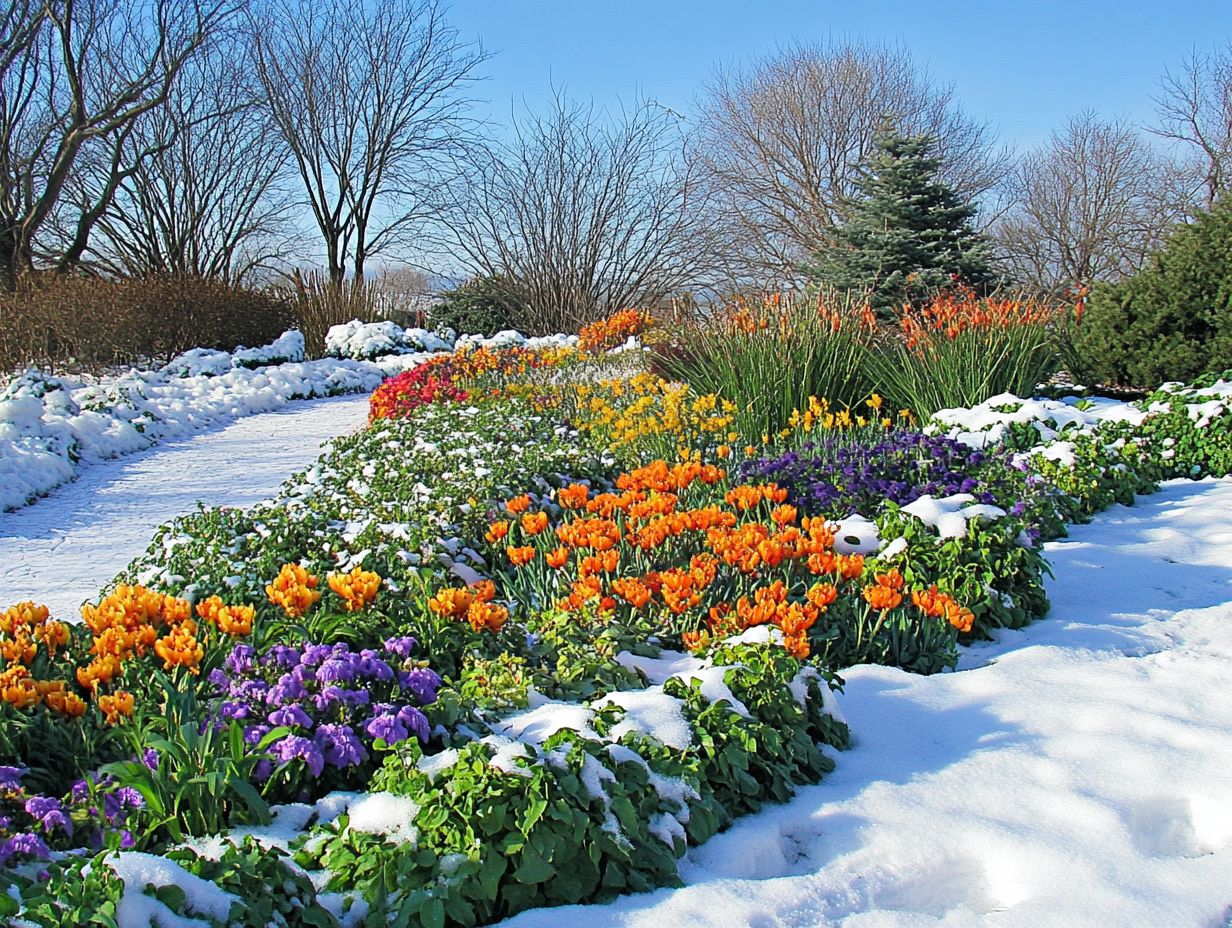
- Choose hardy plants that can withstand cold temperatures.
- Ground covers prevent soil erosion and control weeds, enhancing your landscape.
- Incorporate ground covers into your garden design for added texture and color.
1. Creeping Thyme
Creeping Thyme is a resilient ground cover that flourishes in well-drained soil and basks in full sun. This makes it an exceptional choice for your garden in various climates. Its low-growing perennial nature brings vibrant color and delightful textures, while also offering drought resistance and preventing erosion.
This charming plant displays clusters of vivid flowers throughout the summer, attracting a delightful array of pollinators like bees and butterflies, which are vital for a thriving ecosystem. With its fragrant leaves, Creeping Thyme elevates the visual appeal of your landscape while adding aromatic benefits, making it a truly enchanting addition to your garden.
Its low maintenance requirements make it ideal for those with busy lives, allowing you to enjoy its beauty without the burden of constant upkeep. Creeping Thyme serves as both an attractive and functional solution for enhancing your outdoor spaces.
2. Snow-in-Summer
Snow-in-Summer is a captivating creeping evergreen that blooms with remarkable vibrancy. It flourishes in a range of soil conditions, including those that hold nutrients and offer shade.
This adaptable plant can gracefully weave through rock gardens, borders, and even between stepping stones. It enhances the visual allure of your landscape while complementing taller plants. With its controlled growth, it won t overshadow neighboring flora, making it perfect for anyone seeking to cultivate a balanced garden atmosphere.
The striking contrast of its silvery-white foliage introduces a unique texture, drawing the eye throughout the seasons. As a reliable ground cover, it aids in erosion control and ensures your garden remains an enduring focal point, brimming with interest all year round.
3. Irish Moss
Irish Moss, with its soft, lush foliage, is an exquisite ground cover that thrives in cooler environments. It offers a low-maintenance option to infuse vibrant color and texture into your landscape.
You ll discover unique varieties of Irish Moss, each boasting distinct characteristics tailored to enhance your garden design preferences. This resilient plant beautifies your space and plays a pivotal role in suppressing weeds, allowing neighboring plants to flourish without competition. It improves soil conditions, making it great for nearby plants.
For those looking to harness its hardy nature, consider interplanting Irish Moss with other cold-hardy companions, such as thyme or creeping phlox. This combination can create a stunning tapestry of colors and textures while maximizing your garden’s productivity.
Don t wait! Start planning your cold-hardy garden today for a vibrant oasis in your backyard!
4. Sweet Woodruff
Sweet Woodruff is a delightful low-growing perennial that you ll appreciate for its fragrant leaves. It thrives in shady areas and makes for an ideal ground cover, adding unique foliage to any garden space.
This plant elevates the aesthetic appeal of shaded landscapes and plays a vital role in supporting local insects like bees and butterflies that help plants reproduce. Its small, delicate white flowers in spring attract these beneficial insects, enriching your garden s ecosystem.
As it spreads, Sweet Woodruff acts as a natural erosion control, stabilizing the soil with its extensive root system. This prevents washouts on sloped terrains. Experience seasonal beauty all year long, as its lush green foliage gracefully transitions into a rich autumn hue, ensuring your garden remains vibrant.
5. Alpine Strawberry
The Alpine Strawberry is more than just a flowering plant; it offers stunning blooms and delectable fruits. This vibrant addition provides an easy-care option and serves as a natural mulch provider.
These delightful strawberries catch the eye with their striking flowers and contribute to the health of local pollinators. As a low-maintenance choice, this resilient plant flourishes in various conditions, yielding luscious fruits throughout the warmer months.
With the ability to thrive in poor soil and requiring minimal watering, Alpine Strawberries transform gardening into a stress-free experience. Enjoy delicious harvests without much effort!
6. Blue Star Creeper
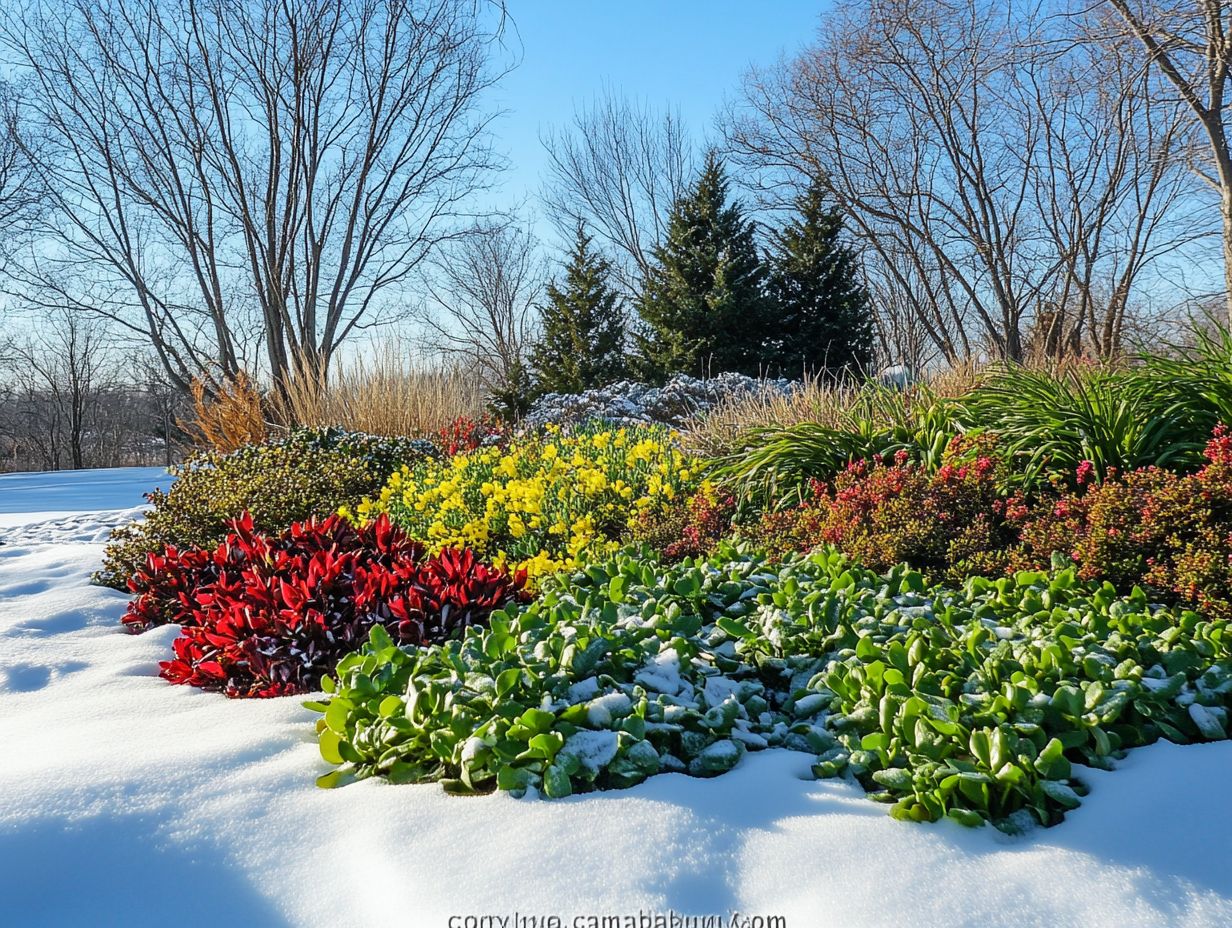
Blue Star Creeper is a delightful creeping evergreen that adds vibrant color to your landscape while controlling erosion as a low-growing perennial.
This charming plant flourishes in various garden settings. Its adaptability with other plants makes it an excellent choice for diverse horticultural designs.
With exceptional drought tolerance, it offers a lush green carpet that endures dry spells and high temperatures. This resilience ensures it remains a striking ground cover that attracts a wealth of pollinators, infusing your garden with life and color.
Its ability to thrive alongside neighboring plants without overshadowing them creates a harmonious outdoor haven.
7. Mazus Reptans
Mazus Reptans is a resilient ground cover that thrives in various soil conditions. It offers you a low-maintenance beauty with its charming flowering plants that bloom abundantly in spring.
This adaptable plant not only enhances your garden’s aesthetics but also prevents soil erosion, thanks to its extensive root system. Its vibrant flowers attract pollinators, enhancing biodiversity.
By incorporating Mazus Reptans alongside cold-hardy companions like sedum and creeping thyme, you create a lush, layered effect while maximizing ecological benefits. This interplanting strategy strengthens your garden’s resilience against harsh weather.
8. Bugleweed
Bugleweed is a stunning ground cover that thrives in shaded areas, creating a lush, colorful carpet adorned with beautiful blooms.
This resilient plant enhances your garden s aesthetic and prevents soil erosion by anchoring the ground with its extensive root system.
If you seek low-maintenance options, bugleweed requires minimal care and adapts well to various soil types. It s an excellent choice for both novice and seasoned gardeners.
Its unique, textured foliage serves as a haven for pollinators, attracting bees and butterflies that enrich your garden’s ecosystem. Beyond its visual charm, this ground cover offers ecological benefits, making it a remarkable addition to any garden.
9. Corsican Mint
Corsican Mint serves as a fragrant ground cover, celebrated for its drought-tolerant qualities and delightful aroma. It s the perfect choice for crafting lush, aromatic havens in your garden.
When you incorporate this herb into your plant combinations, you significantly enhance the variety of life in your garden. It thrives alongside a variety of plants and enriches soil health by improving its structure and moisture retention.
Moreover, Corsican Mint attracts beneficial pollinators like bees and butterflies, fostering a vibrant ecosystem that supports the overall vitality of your garden. By strategically positioning it near flowering plants, you can ensure a symbiotic relationship that promotes both productivity and a stunning visual landscape.
Corsican Mint is a must-have for any gardener looking to create harmony in their green space!
10. Golden Creeping Jenny
Golden Creeping Jenny is a stunning low-growing perennial that adds a splash of vibrant color to your garden, making it an essential element in landscape design and an appealing ground cover option.
This remarkable plant offers a variety of unique cultivars, each showcasing distinct shades of yellow and green that can transform your garden into an eye-catching sanctuary.
Its adaptability allows it to flourish in various soil conditions, whether you re dealing with well-drained sandy soils or heavier clay types. This makes it an incredibly versatile choice for any landscape.
Golden Creeping Jenny also helps prevent soil erosion. Its spreading roots firmly anchor the ground while providing a lush carpet of foliage that shields against the elements.
What Are Ground Covers and Why Are They Important for Cold-Climate Gardens?
Ground covers play a pivotal role in cold-climate gardens, offering a multitude of benefits. They prevent erosion, enhance nutrient retention, and serve as low-maintenance plants that enrich your landscape throughout the seasons. For added beauty, consider the top 10 plants for fall color in cold climates.
Consider hardy options like creeping thyme, phlox, and low-growing sedums. These resilient plants not only endure chilly temperatures with grace but also create a lush tapestry that softens hard edges and fills in barren patches.
As they establish themselves, they form a natural barrier against weeds, allowing the soil to retain moisture and nutrients, which is vital for your garden’s overall health.
Their diverse textures and colors inject visual interest into your space, creating a dynamic outdoor environment that evolves with the seasons. For those looking to enhance their garden, considering the top 5 planters for cold-climate gardening can be beneficial. Ultimately, these ground covers transform your cold-climate garden into a welcome haven, inviting both plants and wildlife to thrive alongside you.
What Are the Key Factors to Consider When Choosing Ground Covers for Cold-Climate Gardens?
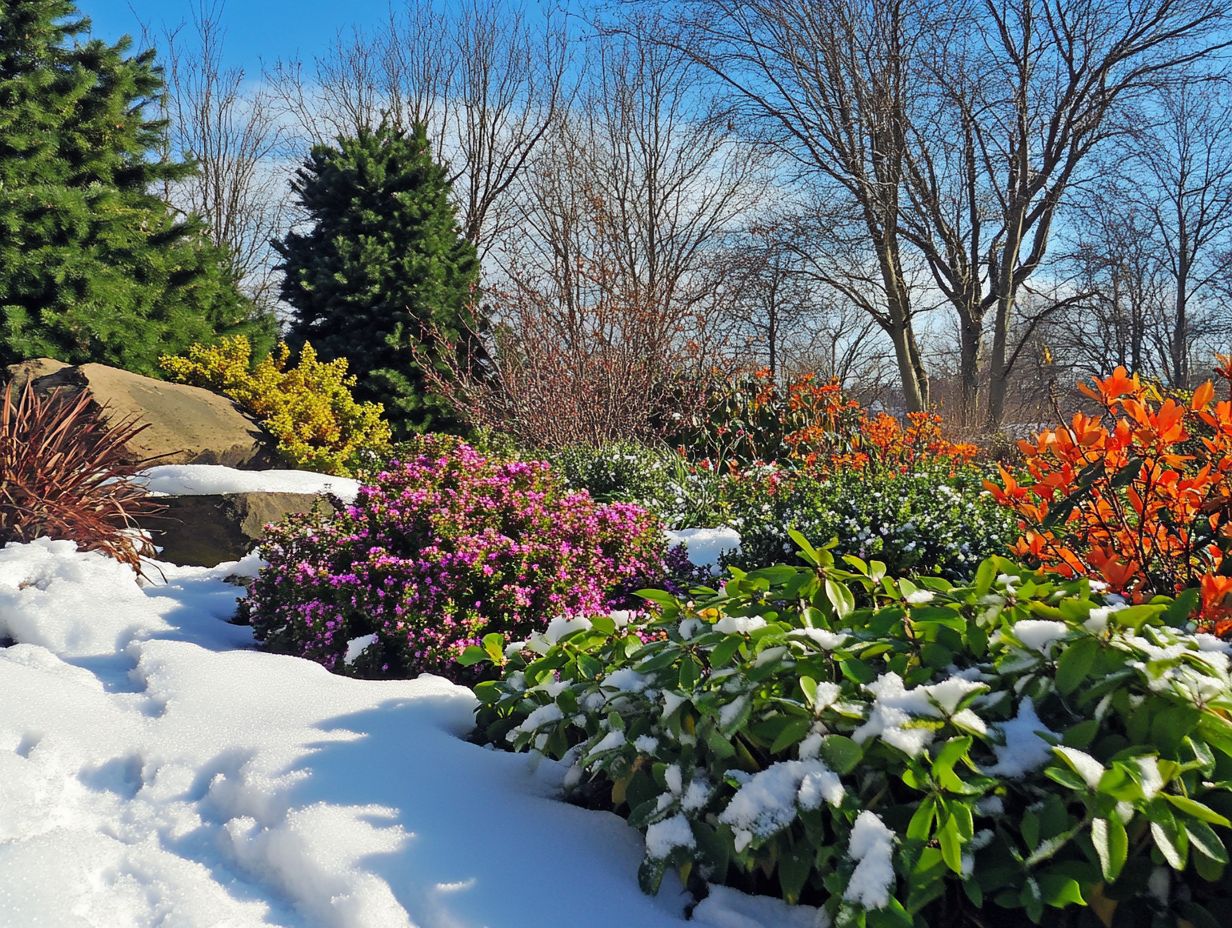
When selecting ground covers for cold-climate gardens, it’s essential to consider key factors such as soil conditions, cold-hardy varieties, and a preference for low-maintenance plants to cultivate a thriving landscape.
Begin by thoroughly understanding your current soil conditions, assessing pH levels, drainage capabilities, and nutritional content, as these elements can significantly influence plant growth. By opting for varieties that are well-adapted to colder temperatures, you not only maintain a vibrant garden year-round but also reduce the need for constant upkeep.
Integrating a thoughtful mix of evergreens, perennials, and seasonal bloomers adds layers of visual intrigue, ensuring there s something to appreciate across the seasons.
By embracing a holistic approach in your selection process, you can create an engaging and resilient outdoor space that withstands the chill.
Don’t hesitate to explore these wonderful ground covers and see how they can transform your garden!
How Can Ground Covers Help with Soil Erosion and Weed Control?
Ground covers are essential for preventing soil erosion and controlling weeds. They serve as a natural mulch while adding beautiful blooms that elevate your garden s aesthetic appeal.
Take creeping thyme, for example. Its delicate purple flowers are not just a feast for the eyes; they thrive in sunny spots. This makes them an excellent choice for rock gardens where soil erosion is a concern.
Then there s vibrant sedum, particularly Sedum acre. This hardy, drought-resistant option is perfect for sloped landscapes that need a little extra care.
When you incorporate these ground covers into your garden design, be sure to evaluate the soil type and sun exposure to maximize their growth potential. Layering different species can create a lush, multi-dimensional effect, blending beauty with practicality while reducing the need for frequent maintenance.
What Are Some Additional Benefits of Using Ground Covers in Cold-Climate Gardens?
Incorporating ground covers in cold-climate gardens presents a wealth of advantages, including low maintenance, support for pollinators, and improved nutrient retention. For optimal results, consider using the top 10 soil amendments for cold-weather gardens throughout seasonal shifts.
These resilient plants also keep weeds at bay. They establish small environments that nurture various species, significantly enhancing overall biodiversity.
Take clover varieties, for example. They are fantastic at fixing nitrogen in the soil, boosting fertility while inviting beneficial insects like bees to your garden.
When selecting the right ground covers think creeping thyme or ajuga you re not just creating a lush carpet that thrives in tough conditions; you re designing an ecosystem. Keep in mind factors such as soil type, sunlight exposure, and moisture levels to cultivate a vibrant, low-maintenance garden that enriches the environment around it.
What Are Some Common Mistakes to Avoid When Using Ground Covers in Cold-Climate Gardens?
Incorporating ground covers into your cold-climate garden can be highly rewarding, but it’s essential to sidestep common pitfalls. These include choosing invasive species or neglecting the specific needs of cold-hardy plants, such as those highlighted in the top 5 shrubs for cold-climate gardens.
Selecting the right varieties is key to ensuring long-term success and minimizing maintenance challenges. Often, gardeners overlook the importance of understanding how different plants behave. This oversight can lead to less-than-ideal results.
For example, failing to consider growth habits or light requirements can hinder the establishment of a flourishing ground cover. When you’re choosing ground covers, take the time to research their adaptability to your local soil conditions and climate variations.
This knowledge promotes resilient growth and helps you create a harmonious garden ecosystem that supports diverse wildlife and combats erosion.
How Can a Gardener Incorporate Ground Covers into Their Overall Garden Design?
Incorporating ground covers into your overall garden design requires a keen eye for landscape management strategies and interplanting ideas. For those with small, cold-climate balconies, consider the top 10 plants to maintain seasonal interest with the right cold-hardy varieties.
By thoughtfully choosing ground covers based on their color palette and texture, you can create a visually cohesive look that transforms your garden throughout the seasons. For example, pairing vibrant flowering varieties with lush, green foliage adds depth to your flower beds. This also promotes biodiversity by offering habitats for pollinators.
It s essential to assess the ecological benefits of different ground covers, such as their ability to suppress weeds, enhance soil health, and retain moisture. This approach elevates your garden s aesthetic appeal while supporting sustainable practices, ensuring that each plant selection serves multiple purposes within the vibrant tapestry of your landscape.
Frequently Asked Questions
Here are some common questions about ground covers for cold-climate gardens:
What are the top 10 ground covers for cold-climate gardens?
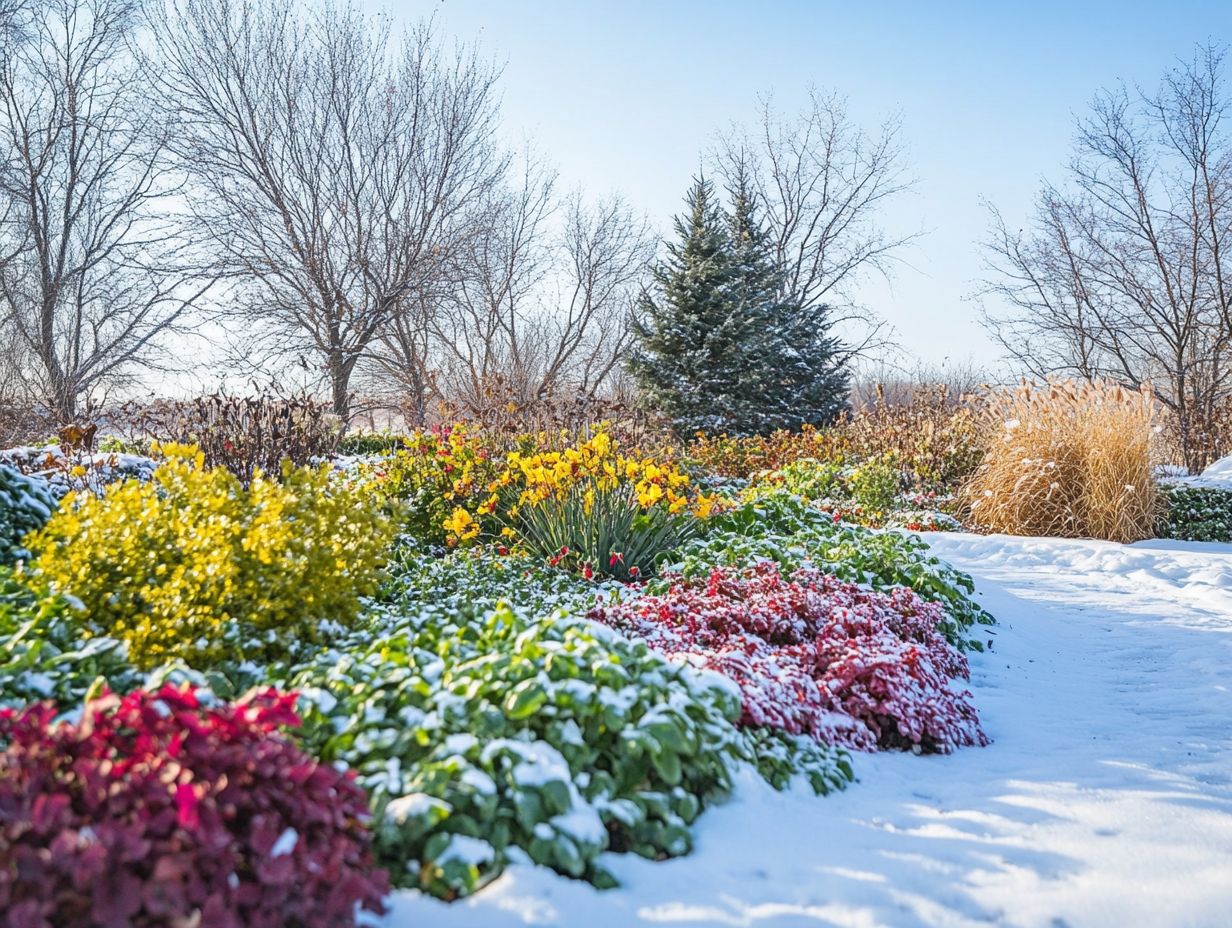
The top 10 ground covers for cold-climate gardens are: creeping thyme, creeping phlox, creeping sedum, Irish moss, snow-in-summer, creeping juniper, bearberry, Siberian carpet cypress, hardy ice plant, and woolly thyme.
Ready to enhance your garden? Visit your local nursery or research specific ground cover varieties today!
What is the benefit of using ground covers in a cold-climate garden?
Ground covers help retain moisture and insulate the soil. This creates a stable environment for plants to thrive in colder climates.
They control weeds and erosion. Plus, ground covers add visual interest to the garden!
Are all ground covers suitable for cold-climate gardens?
No, not all ground covers are suitable for cold-climate gardens. Some may not survive harsh winter conditions and will die off, but you can find options like the top 5 shade-tolerant plants for cold climates that thrive even in challenging conditions.
It s essential to choose plants that grow well in colder areas.
How do I choose the right ground cover for my cold-climate garden?
Look for hardy plants that can withstand freezing temperatures. Also, consider sunlight and soil conditions to ensure they will thrive.
Do ground covers require a lot of maintenance?
It depends on the type of ground cover. Generally, they are low-maintenance plants.
They may need occasional pruning or weeding, but typically do not require much attention once established.
Can I use ground covers as a lawn replacement in my cold-climate garden?
Yes! Ground covers can be a fantastic alternative to traditional lawns. They provide a natural and visually appealing option.
They also help conserve water and reduce the need for mowing and fertilizing.


